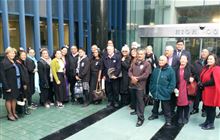Conservation Board looks forward to court of appeal decision before the end 2019
Introduction
The Taranaki-Whanganui Conservation Board was one of many cross-appellants appearing before the Court of Appeal this week.The hearing was held 24 – 26 September 2019, and has now concluded. The President of the Court of Appeal, Kos P, presiding over the three-member bench of the Court of Appeal, indicated that a decision would be likely before the end of the year.
In August 2018, the High Court quashed the marine consent granted to Trans-Tasman Resources Limited (TTRL) by the Environmental Protection Authority (EPA) for TTRL to undertake seabed mining in the South Taranaki Bight. In doing so, the High Court upheld appeals by the Taranaki-Whanganui Conservation Board and others against the marine consent. The High Court found that the EPA, through its Decision Making Committee (DMC), had erred in allowing TTRL to use an “adaptive management approach” to its consent – when that approach was not allowed for a marine discharge consent under the EEZ Act.
TTRL appealed the High Court’s decision to the Court of Appeal, seeking to overturn the High Court’s decision and reinstate its mining consent.
The Conservation Board resolved to defend the High Court’s decision, as well as to cross-appeal in order to have the High Court’s decision confirmed on other grounds.
The Conservation Board co-ordinated closely with other cross-appellants, in particular Iwi and Fisheries interests, in the hearing before the High Court. Joint submissions were presented, with the Conservation Board’s Counsel, Mr Gardner-Hopkins, taking the lead on a question of law relating to how the “nature and effect” of the Resource Management Act 1991 (RMA) and the New Zealand Coastal Policy Statement (NZCPS) should have been “taken into account” by the DMC. The issue is an important one, given that most of the effects of TTRL’s proposal will fall within the Coastal Marine Area, and some of those effects were identified as “significant”. For example, the DMC found that there would be “significant adverse effects within ecologically significant areas” within the Coastal Marine Area. The RMA and NZCPS weigh very heavily against allowing such effects.
Board Chair, Vicky Dombroski, said ‘the Board is pleased to have had its concerns heard by the Court of Appeal, and looks forward to the Court’s decision, which it has indicated should be released before the end of the year’.
‘The issues are very important to the Board, given its conservation management functions which extend into the EEZ as well as applying to the Coastal Marine Area. It welcomes the guidance that will be given by the Court of Appeal as to what is required to meet the EEZ’s “protect from pollution” purpose, the duty to make decisions on the best available information, and apply the precautionary principle.'
‘The Board also specifically sought to clarify how the EPA should have taken into account the Resource Management Act and in particular the strong directives of the New Zealand Coastal Policy Statement, which weigh heavily against allowing the significant effects in the Coastal Marine Area that the DMC found would occur.’
The Board is an independent statutory body constituted under the Conservation Act. Its functions include conservation management and the Board was concerned to ensure that the EPA’s decision was made in accordance with the statutory tests established under the Exclusive Economic Zone (EEZ) legislation.
By way of background, TTRL lodged this (second) application for marine consents with the EPA in August 2016. The EPA’s decision to grant TTRL’s second application was made in August 2017 and required a casting vote from the chairperson of the EPA’s four-member Decision Making Committee.
This also followed an earlier application by Trans-Tasman Resources for the same activity, lodged in November 2013 and declined by the EPA in June 2014. The Board had also opposed that earlier application.

